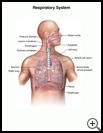
Collapsed Lung (Pneumothorax) Discharge Information
What is a collapsed lung?
A collapsed lung, also called a pneumothorax, happens when air enters the space between your rib cage and one of your lungs. The air makes it hard for the lung to expand and causes all or part of the lung to collapse. It is then hard to breathe normally and your body gets less oxygen. A collapsed lung can be life-threatening. In some cases, the air collecting around the lung can completely collapse the lung and put pressure on the heart. Then the heart cannot pump normally.
A collapsed lung may be caused by an injury to the chest, such as a car accident, stab or bullet wound, or broken ribs. It may also be caused by lung damage from chronic lung diseases, electric shock, or near drowning.
Sometimes there is no known cause for the lung to collapse. This is called a spontaneous pneumothorax. It may be caused by having a history of smoking and chronic obstructive pulmonary disease (COPD).
How can I take care of myself when I go home?
How long it takes to get better depends on the cause of your collapsed lung, your treatment, how well you recover, your overall health, and any complications you may have.
Management
- Your provider will give you a list of your medicines when you leave the hospital.
- Know your medicines. Know what they look like, how much you should take each time, how often you should take them, and why you take each one.
- Take your medicines exactly as your provider tells you to.
- Carry a list of your medicines in your wallet or purse. Include any nonprescription medicines and supplements on the list.
- Talk to your provider before you use any other medicines, including nonprescription medicines.
- Ask your healthcare provider if you should take aspirin and if so, how much to take. Taking a low-dose aspirin every day may help prevent a heart attack or stroke. However, not everyone should take aspirin.
- Your provider may prescribe medicine to:
- Treat pain
- Treat or prevent an infection
- Reduce swelling in the airways
- Help relax your airways
- Your provider may recommend other types of therapy to help relieve pain, other symptoms, or side effects of treatment.
- If you have had surgery, to care for your surgical wound:
- Keep your surgical wound clean.
- If you are told to change the dressing on your surgical wound, wash your hands before changing the dressing and after disposing of the dressing.
- Follow activity restrictions, such as not driving or operating machinery, as recommended by your healthcare provider or pharmacist, especially if you are taking pain medicines.
- Drink enough fluids to keep your urine light yellow in color, unless you are told to limit fluids.
- Take care of your health. Try to get at least 7 to 9 hours of sleep each night. Eat a healthy diet and try to keep a healthy weight. If you smoke, try to quit. If you want to drink alcohol, ask your healthcare provider how much is safe for you to drink. Learn ways to manage stress. Exercise according to your healthcare provider's instructions.
Appointments
- Follow your provider's instructions for follow-up appointments.
- Keep appointments for any testing you may need.
Talk with your provider about any questions or concerns you have.
Call emergency medical services or 911 if you have new or worsening:
Chest pain that does not get better with medicine
- Coughing up blood
- Trouble breathing
- Bluish or gray color of your lips or fingernails
- Feeling like you are going to die
Do not drive yourself if you have any of these symptoms.
Call your healthcare provider if you have new or worsening:
- Anxiety
- Chest pain when you take a breath
- Trouble breathing that wakes you at night or having shortness of breath when lying flat in bed
- Wheezing
- Coughing up mucus that is thick or blood-stained
- Chills or sweats
- Confusion
- Signs of infection around your surgical wound. These include:
- The area around your wound is more red or painful
- Your wound area is very warm to touch
- You have blood, pus, or other fluid coming from the wound area
- You have a fever higher than 101.5° F (38.6° C)
- You have chills or muscle aches
Last modified: 2016-04-15
Last reviewed: 2016-01-19

